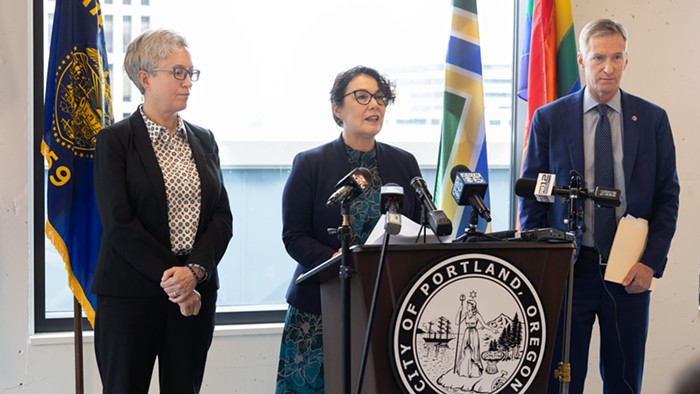Six months ago, Mayor Sam Adams disappointed environmental and smart transit groups when he voted in favor of a Columbia River Crossing bridge up to 12 lanes wide. Today he has rescinded that support.
"I’m committed to making fact based decisions," Adams told the Mercury this morning. "Based on the facts, I think every aspect of this bridge has to shrink, including the number of lanes."

- Brett Superstar.
- I rescind this caricature.
Adams continued that he believes Oregon and Washington are now looking at six to 10 lane window for the new I-5 bridge planned across the Columbia River. The size of the new bridge is controversial not only because of its pricetag (the 12 lane bridge clocks in at an estimated $4.2 billion) but because expanding the size of the bridge by six lanes would increase traffic capacity, leading to more driving, more greenhouse gas emissions and more sprawl.
"Some people are going to say, "Why would you spend money going from a six lane bridge to another six lane bridge?' But we often replace outdated bridges with another bridge of the same size," says Adams. Light rail would run under the six or eight lane bridge.
Adams says the facts of a changed "political and fiscal context" influenced his decision to back away from supporting a 12-lane bridge. "The federal delegation made it clear that this project is hundreds of millions of dollars more expensive than they can afford to invest in," says Adams. Reducing the number of lanes and freeway interchanges involved in the project would cut the cost. Adams also cited "the growing opposition on the north side of the Columbia river to tolling" in his decision. "I don’t think it’s realistic to get this project built at any size without tolls and I wouldn’t support it. Without tolls, the daily gridlock on the Columbia River Crossing moves to the heart of the city of Portland. No mayor in their right mind would ever sign off on that."
It's interesting that Adams primarily cited the anti-toll protests of Vancouverites, not the anti-12 lane protests of progressive Portlanders. When asked about the protests close to home, Adams replied, "Of course I’m always keen to listen to what my constituents have to say. I'm the first to admit that my position in February/March on the compromise of the bridge structure being up to 12 lanes, I'm the first to admit that that nuance was lost a lot of the discussion. A lot of the push back I got was, 'Why did you sign off on twelve lanes?' I've found the discussion helpful."
This is major news for groups and individuals committed to cutting down the size of the largest transportation project in our region's history—it looks like they've now got the head of City Hall on their side.
Update 1:40 PM! Coincidentally, the bridge design advisory group today agreed on a rough aesthetic vision for the bridge. It's not an exciting design in my opinion but, hey, never-before-published drawings are below the cut so you can decide for yourself.




















